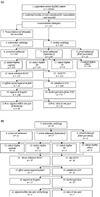Difference in end-tidal CO2 between asphyxia cardiac arrest and ventricular fibrillation/pulseless ventricular tachycardia cardiac arrest in the prehospital setting
- PMID: 14624688
- PMCID: PMC374361
- DOI: 10.1186/cc2369
Difference in end-tidal CO2 between asphyxia cardiac arrest and ventricular fibrillation/pulseless ventricular tachycardia cardiac arrest in the prehospital setting
Abstract
Introduction: There has been increased interest in the use of capnometry in recent years. During cardiopulmonary resuscitation (CPR), the partial pressure of end-tidal carbon dioxide (PetCO2) correlates with cardiac output and, consequently, it has a prognostic value in CPR. This study was undertaken to compare the initial PetCO2 and the PetCO2 after 1 min during CPR in asphyxial cardiac arrest versus primary cardiac arrest.
Methods: The prospective observational study included two groups of patients: cardiac arrest due to asphyxia with initial rhythm asystole or pulseless electrical activity, and cardiac arrest due to acute myocardial infarction or malignant arrhythmias with initial rhythm ventricular fibrillation (VF) or pulseless ventricular tachycardia (VT). The PetCO2 was measured for both groups immediately after intubation and then repeatedly every minute, both for patients with and without return of spontaneous circulation (ROSC).
Results: We analyzed 44 patients with asphyxial cardiac arrest and 141 patients with primary cardiac arrest. The first group showed no significant difference in the initial value of the PetCO2, even when we compared those with and without ROSC. There was a significant difference in the PetCO2 after 1 min of CPR between those patients with ROSC and those without ROSC. The mean value for all patients was significantly higher in the group with asphyxial arrest. In the group with VF/VT arrest there was a significant difference in the initial PetCO2 between patients without and with ROSC. In all patients with ROSC the initial PetCO2 was higher than 10 mmHg.
Conclusions: The initial PetCO2 is significantly higher in asphyxial arrest than in VT/VF cardiac arrest. Regarding asphyxial arrest there is also no difference in values of initial PetCO2 between patients with and without ROSC. On the contrary, there is a significant difference in values of the initial PetCO2 in the VF/VT cardiac arrest between patients with and without ROSC. This difference could prove to be useful as one of the methods in prehospital diagnostic procedures and attendance of cardiac arrest. For this reason we should always include other clinical and laboratory tests.
Figures

Comment in
-
Capnography during cardiac resuscitation: a clue on mechanisms and a guide to interventions.Crit Care. 2003 Dec;7(6):411-2. doi: 10.1186/cc2385. Epub 2003 Oct 6. Crit Care. 2003. PMID: 14624676 Free PMC article.
Similar articles
-
The dynamic pattern of end-tidal carbon dioxide during cardiopulmonary resuscitation: difference between asphyxial cardiac arrest and ventricular fibrillation/pulseless ventricular tachycardia cardiac arrest.Crit Care. 2011;15(1):R13. doi: 10.1186/cc9417. Epub 2011 Jan 11. Crit Care. 2011. PMID: 21223550 Free PMC article.
-
Initial end-tidal CO2 is markedly elevated during cardiopulmonary resuscitation after asphyxial cardiac arrest.Pediatr Emerg Care. 1996 Aug;12(4):245-8. doi: 10.1097/00006565-199608000-00002. Pediatr Emerg Care. 1996. PMID: 8858644
-
Changes of end-tidal carbon dioxide during cardiopulmonary resuscitation from ventricular fibrillation versus asphyxial cardiac arrest.World J Emerg Med. 2014;5(2):116-21. doi: 10.5847/wjem.j.issn.1920-8642.2014.02.007. World J Emerg Med. 2014. PMID: 25215160 Free PMC article.
-
Capnography during cardiac arrest.Resuscitation. 2018 Nov;132:73-77. doi: 10.1016/j.resuscitation.2018.08.018. Epub 2018 Aug 22. Resuscitation. 2018. PMID: 30142399 Review.
-
Beta-blockade for the treatment of cardiac arrest due to ventricular fibrillation or pulseless ventricular tachycardia: A systematic review and meta-analysis.Resuscitation. 2020 Jan 1;146:118-125. doi: 10.1016/j.resuscitation.2019.11.019. Epub 2019 Nov 29. Resuscitation. 2020. PMID: 31790759
Cited by
-
Repeated or long-duration TASER electronic control device exposures: acidemia and lack of respiration.Forensic Sci Med Pathol. 2010 Mar;6(1):46-53. doi: 10.1007/s12024-009-9126-4. Forensic Sci Med Pathol. 2010. PMID: 19936976 Review.
-
Capnography during cardiac resuscitation: a clue on mechanisms and a guide to interventions.Crit Care. 2003 Dec;7(6):411-2. doi: 10.1186/cc2385. Epub 2003 Oct 6. Crit Care. 2003. PMID: 14624676 Free PMC article.
-
Pediatric basic and advanced life support: 2010 International Consensus on Cardiopulmonary Resuscitation and Emergency Cardiovascular Care Science with Treatment Recommendations.Pediatrics. 2010 Nov;126(5):e1261-318. doi: 10.1542/peds.2010-2972A. Epub 2010 Oct 18. Pediatrics. 2010. PMID: 20956433 Free PMC article. No abstract available.
-
Effects of epinephrine and vasopressin on end-tidal carbon dioxide tension and mean arterial blood pressure in out-of-hospital cardiopulmonary resuscitation: an observational study.Crit Care. 2007;11(2):R39. doi: 10.1186/cc5726. Crit Care. 2007. PMID: 17376225 Free PMC article.
-
End-Tidal CO2-Guided Chest Compression Delivery Improves Survival in a Neonatal Asphyxial Cardiac Arrest Model.Pediatr Crit Care Med. 2017 Nov;18(11):e575-e584. doi: 10.1097/PCC.0000000000001299. Pediatr Crit Care Med. 2017. PMID: 28817508 Free PMC article.
References
-
- Falk JL, Rackow EC, Weil MH. End-tidal carbon dioxide concentration during cardiopulmonary resuscitation. N Engl J Med. 1988;318:607–611. - PubMed
-
- Weil MH, Bisera J, Trevino RP, Rackow EC. Cardiac output and end-tidal carbon dioxide. Crit Care Med. 1985;13:907–909. - PubMed
-
- Callaham M, Barton C. Prediction of outcome of cardiopulmonary resuscitation from end-tidal carbon dioxide concentration. Crit Care Med. 1990;18:358–362. - PubMed
Publication types
MeSH terms
LinkOut - more resources
Full Text Sources
Medical

